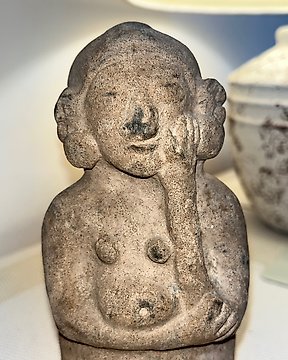
Tumaco-Tolita Terracotta Έγκυος γυναίκα σε θέση σκέψης - 23 cm
Αρ. 83275723

Αρ. 83275723

Bowl.
Maya, 650 - 800 AD
Terracotta.
15 cm diameter.
PROVENANCE: Private collection of Mario Villa (1953 - 2021). Mario Villa is known as a collector, artist, designer and furniture manufacturer in New Orleans, United States of America.
CONDITION: Good condition. Repaired from the original fragments.
DESCRIPTION:
The Mayan culture developed from earlier groups of village dwellers and farmers that lived the area and participated in the trade network. They also were influenced by groups living in what is now central Mexico, mainly the Olmecs. Around the 10th Century CE, lack of rain, ecological deterioration and social unrest resulted in the abandonment of the Mayan’s large urban centers. Later, groups of Mayan origin settled on the Yucatan Peninsula where they joined with other groups from central Mexico, mainly Toltecs, to build new civic and ceremonial centers such as Chichén Itza and Mayapán, which remained active until the arrival of the Spaniards in 1525. Today, the descendants of these ancient Mayans still live in the area that stretches from the Yucatán Peninsula to Honduras, where they continue their way of life, wear traditional clothing and speak the language handed down to them by this ancient American culture.
The Maya civilization extended over a large area, from present-day south-central Mexico to Guatemala and Honduras. The area has three distinct geographic regions—the mountains and highlands, the tropical jungle lowlands, and the lowlands of the Gulf of Mexico and the Yucatan Peninsula—each with its own landscape and natural resources. During the Classical Period, the Mayans lived in the highlands and lowlands, in which Tikal and Kaminaljuyú were their major population centers, respectively.
The Mayans developed a unique artistic style with a degree of complexity that rivals that of European baroque. Their extremely life-like, anatomically proportionate human images are found in natural poses that emphasize movement. Their art represented sacred, ritual and hierarchical themes, although they also reproduced scenes from daily life and images of local fauna such as monkeys, tapirs, jaguars, bats, quetzal birds, fish and turtles. Stone was one of their favorite media, and they used it for their buildings, stelas, and the low- and high-relief sculptures that adorned their buildings. The Mayan’s architectural contributions include the stela-altar, the arch and the false vault. In addition to monumental art they also had a highly developed personal esthetic, manufacturing ear ornaments, pendants, necklaces, masks and other adornments out of jade. They deformed their craniums and noses and hung ornaments on their foreheads to make them squint-eyed.
They decorated their pottery with painted and engraved images, producing some of the finest works of pre-Columbian art. Popular Mayan ceramic pieces included serving bowls, pipes and vases, the last of these often adorned with Mayan glyphs.
Notes:
- The piece includes authenticity certificate.
- The piece includes Spanish Export License.
- The seller guarantees that he acquired this piece according to all national and international laws related to the ownership of cultural property. Provenance statement seen by Catawiki.
Πώς να πραγματοποιήσετε αγορές στην Catawiki
1. Ανακαλύψτε κάτι ιδιαίτερο
2. Υποβάλετε την κορυφαία προσφορά
3. Πληρώστε με ασφάλεια